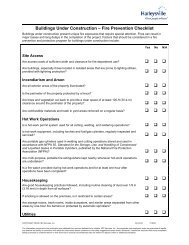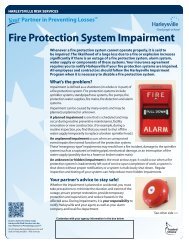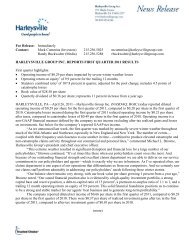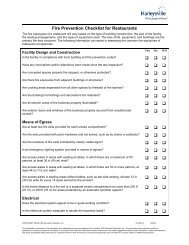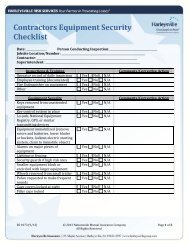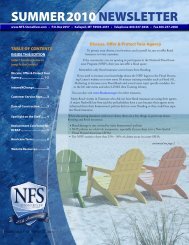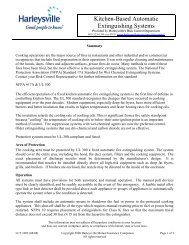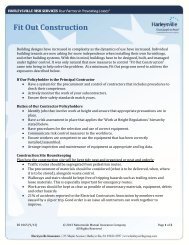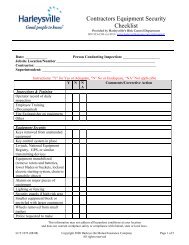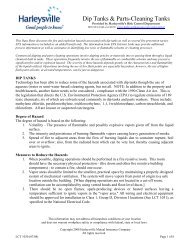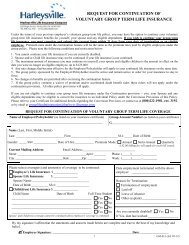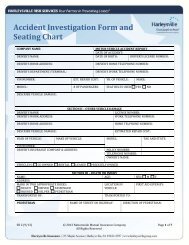New York Labor Law (Z-1551) - Harleysville Insurance
New York Labor Law (Z-1551) - Harleysville Insurance
New York Labor Law (Z-1551) - Harleysville Insurance
Create successful ePaper yourself
Turn your PDF publications into a flip-book with our unique Google optimized e-Paper software.
NEW YORK LABOR LAW 3Examples of incidents causing NYLL lawsuitsagainst property owners• With a property owner acting as a general contractor, a subcontractor’s employee fallsfrom a ladder while using a circular saw—sustaining severe injuries to his left arm.• A worker stands on two paint buckets to work over a doorway, falls and is seriouslyinjured.• A construction worker falls 30 feet to the ground when a handrail comes loose on afire escape.• A worker falls while using a property owner’s unopened A-frame ladder that was proppedup against a wall.• A subcontractor’s construction worker is injured by ductwork being lowered from theproperty owner’s lift.• An employee of a contractor falls from a ladder while installing gutters.• A contractor’s worker falls from a suspended scaffold.Protecting your assets:Some questions to ask when choosing a contractor• Can a general contractor be used if there is a need to subcontract work to others?• Is the contractor competent, properly licensed and experienced?• Does the contractor properly screen the subcontractors they hire?• Are written agreements in place with all subcontractors that contain indemnificationlanguage in the property owner’s favor and require that the owner be an additional insuredunder the subcontractor’s insurance policies?• Have references and complaints/incidents been checked?• Is the contractor’s equipment new (or well-maintained)—especially ladders?• Does the contractor have safety and employee training programs in place?• Are safety procedures in place for ladders, scaffolding and fall protection?• What safeguards are in place to prevent accidents and injuries?• Is there a history of OSHA violations?
NEW YORK LABOR LAW 5345YOUR 5 ESSENTIAL MINIMUM CONTRACT REQUIREMENTS (cont’d.)<strong>Insurance</strong> requirements and additional insured coverage—property ownerEXAMPLE: The contractor shall obtain insurance covering the property owner andproperty manager as additional insureds for any liability arising out of the work withlimits not less than $1 million. (Note: Shareholders or unit owners of condominiums orco-ops should require contractors to include the property owner and property managementfirm as additional insureds.) This insurance shall be primary insurance and any otherinsurance covering the property owner and property manager shall be non-contributory.The coverage must be provided for both ongoing and completed operations. The coveragemust be provided through coverage forms using standard ISO wording and must notinclude language that would limit or exclude the standard ISO coverage for injuries tothe contractor’s employees or the employees of any agent, servant or subcontractor, orexclude contractual indemnification and/or change the definition of an insured contractto exclude coverage for the very type of contract that would transfer the risk to thesubcontractor. The measure of damage for failing to provide the necessary coverage isnot limited to the cost of premium.Waiver of subrogation and workers compensation immunityEXAMPLE: The contractor agrees to waive any and all rights of subrogation againstthe property owner and property manager. In addition, the contractor agrees theindemnification obligation shall not be limited in any way by any limitation on theamount or type of damages, compensation or benefits payable by or for the contractorunder workers compensation acts, disability benefit acts or other employee benefit acts.Certificate of insurance requirementEXAMPLE: A certificate of insurance must be provided to the property owner andproperty manager prior to the commencement of work as evidence the contractor ismaintaining its own general liability and workers compensation insurance withsufficient limits to cover a significant loss. The certificate must show the propertyowner and property manager as additional insureds for ongoing and completedoperations on a primary and non-contributory basis.“But I’m a property owner—not a lawyer or insurance professional.”Executing contracts and risk transfer agreements are common practices in your industry.Choose a competent and qualified attorney to review your contracts, risk transfer requirementsand procedures. You also may want to consider using “standard” contracts, such as “AIA” or“Consensus Docs.”Your insurance agent is an excellent resource and can provide additional assistance such asidentifying insurance companies that limit or exclude contractual liability coverages—whichcould increase your liability. And in matters involving <strong>New</strong> <strong>York</strong> <strong>Labor</strong> <strong>Law</strong>, it’s especiallyimportant to seek professional advice!
NEW YORK LABOR LAW 6Other information of value to property ownersA word about leases, tenants and the NYLLNYLL suits can arise from the actions of your tenants. As a property owner, you can be heldliable for injuries to workers and others that your tenant has hired for construction, alteration,repair and maintenance.To better protect your organization from the hazards associated with uninsured orinadequately insured commercial tenants:• Obtain certificates of insurance from all commercial tenants.• Implement procedures to assure certificates are obtained—and updated as they expire.• Specify policy limits for general liability (GL) and workers compensation (WC) on allcertificates of insurance. These limits must be “equal to or higher than” the limits of yourpolicies. The tenant must carry a minimum of $1 million of GL coverage.• Insist that you are named as an “additional insured” through an endorsement that providesprimary and non-contributory coverage for general liability, product liability andcompleted operations liability. (Your agent knows which form to use.)• Require tenants to sign written agreements with defense/indemnity/hold harmlesslanguage that requires them, to the fullest extent permitted by law, to accept liabilitycaused either by their actions or their actions and your actions combined. Never agree toaccept liability for accidents caused by the actions of a commercial tenant.• Review and revise leases with the assistance of a competent attorney. If necessary, addnew language to your current leases for all commercial tenants.Common pitfalls that increase your liability• A handshake agreement rather than a written contract• A verbal agreement with a long-time associate—instead of a written contract• Contracts that do not include insurance requirements• An assumption that a contractor has insurance• A contractor whose insurance coverage excludes contractual liability• A contractor’s certificate of insurance that has expired• Allowing use of your tools and equipment by others not employed by you• Failure to adequately screen contractors• Work that proceeds before risk transfer agreements are in place• A contract that does not include indemnification language• A contract that does not include language requiring the additional insured coverage for theowner/property manager to be applicable on a primary/non-contributory basis
NEW YORK LABOR LAW 7Additional resources available from <strong>Harleysville</strong>To provide you with further protection against the risk of a lawsuit, the following materialsare available from <strong>Harleysville</strong> Risk Services:Additional materials• Managing Contracts to Limit Sources of Contractual Liability—LCT-1060• Certificates of <strong>Insurance</strong> Fact Sheet—Z-1465• Real Estate Owners Best Practices—LCT-1052For help with obtaining these materials, contact <strong>Harleysville</strong> Risk Services at 800.523.6344,ext. 8100, or by email at riskservices@harleysvillegroup.com.
Risk Services Department<strong>Harleysville</strong> <strong>Insurance</strong>355 Maple Avenue<strong>Harleysville</strong>, PA 19438-2297Tel: 800.523.6344, ext. 8100Fax: 215.513.5345riskservices@harleysvillegroup.comwww.harleysvillegroup.comScan to learn the many ways<strong>Harleysville</strong> Risk Services can beYour Partner in Preventing Losses SM .Or, visit www.harleysvillegroup.com andclick on Policyholders > Risk services.This information is designed to help users address their own risk management and insurance needs, and is not intended tobe legal advice. Although we go to great lengths to make sure our information is accurate and useful, we do not warrant itsaccuracy or completeness, and we recommend you consult your insurance agent or other insurance professional, includinga licensed attorney, to ensure that this information, and your interpretation of it, is appropriate to your particular situation.This information does not address all conditions, and may not be in compliance with federal, state or local laws.© 2012 <strong>Harleysville</strong> Group Inc. All rights reserved. Z-<strong>1551</strong> 10/12



